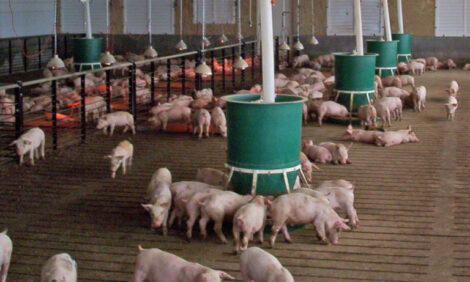



Food Outlook Global Market Analysis - Pigmeat
By FAO. Rebounding demand together with tight supplies and rising production costs sustain meat prices in 2007Prices
FAO's meat price index recovered from the low value of 112 in March 2006 to 123 in August 2007 (1998-2000=100), reflecting higher prices for all the three major groups of meat, i.e. bovine, pig and poultry meat. With increased costs of production in major producing countries, the rise in prices can be expected to continue. In August, beef prices were almost 6 percent above year earlier levels, sustained by a strong import demand and limited export supplies, especially in Australia. Despite a slight tendency for pigmeat prices to firm over the year, by August 2007 the FAO's pigmeat price index stood at only 99 points; up from 96 in August 2006. Much of the growth reflected developments in China where low domestic supplies have converted the country from a net exporter to a net importer. Currently, the main source of the increase in FAO's global pigmeat index is a gain of around 12 percent in the wholesale price of pork loins from the United States between January and August of 2007. On the supply side, the price pattern was also influenced by rising feed and energy costs. From January to August 2007, average poultry export prices in Brazil and the United States had increased by 21 and 30 percent, respectively, compared with the same period in 2006. The export price strength largely reflects the continued recovery of global poultry import demand in 2007, despite a recurrence of avian influenza in different parts of the world and sharply higher feed and energy costs. These specific market developments were captured in the FAO poultry price index, which strengthened considerably since January, reaching 136 points in August 2007, the highest level observed in the last ten years.

| Table 8. World meat markets at a glance | |||||
| 2005 | 2006 estim. | 2007 f'cast | Change: 2007 over 2006 | ||
|---|---|---|---|---|---|
| million tonnes | % | ||||
| WORLD BALANCE | |||||
| Production | 269.3 | 275.7 | 278.3 | 1.0 | |
| Bovine meat | 64.5 | 66.2 | 67.1 | 1.3 | |
| Poultry | 82.9 | 83.7 | 86.2 | 3.0 | |
| Pigmeat | 103.7 | 106.9 | 105.8 | -1.0 | |
| Ovine meat | 12.9 | 13.6 | 13.8 | 2.1 | |
| Trade | 20.6 | 21.1 | 21.4 | 1.5 | |
| Bovine meat | 6.6 | 6.8 | 7.0 | 2.5 | |
| Poultry | 8.2 | 8.1 | 8.2 | 1.3 | |
| Pigmeat | 4.8 | 5.0 | 5.0 | 0.7 | |
| Ovine meat | 0.8 | 0.8 | 0.8 | -0.3 | |
| SUPPLY AND DEMAND INDICATORS | |||||
| Per caput food consumption: | |||||
| World | kg/year | 39.5 | 40.0 | 40.0 | 0.0 |
| Developed | kg/year | 58.6 | 59.0 | 59.3 | 0.6 |
| Developing | kg/year | 31.0 | 31.6 | 31.6 | -0.1 |
| FAO Price Index | (1998-2000=100) | 121 | 115 | 1201 | |
| 1 Jan-Aug 2007 | |||||
Developments in China strongly influence the world pigmeat sector in 2007
Global pigmeat production in 2007 is forecast to fall by 1 percent to 105.8 million tonnes. The principal reason for the decline is a major contraction of output in China, where the sector was much affected by a massive pig culling following an outbreak of PRRSV disease and high feed prices. In South America, an increase in pigmeat production is anticipated in the main producing countries. Brazil and Chile, which harvested record soybean and corn crops, are the main forces sustaining the output expansion in the region. In the European Union, pigmeat production is forecast to grow only slightly in 2007, constrained by rising feed costs and recent outbreaks of swine fever in both Bulgaria and Romania. In the Russian Federation, production is set to expand as pig numbers have increased by more than 10 percent, sustained by government support under policies aimed at boosting domestic production and at lowering import dependency over the medium term. Pigmeat output in Australia may increase in the short term due to a reduction inventories, caused by a combination of drought-induced grain price increases (feed grain accounts for approximately 40 percent of feed input), record imports and the strengthening of the Australian Dollar. Pigmeat output in Canada is likely to decline along with the pig breeding herd, as the processing industry continues to consolidate, also pressured by the strong Canadian Dollar. In the United States the outlook for pigmeat production is favourable as slaughter weights in 2007 are close to those of the previous year, while slaughter numbers are increasing. In North America, pork retail prices have risen, as the sector has been able to pass some of the increase in production costs to consumers.World trade in pigmeat is estimated to remain in the order of 5.0 million tonnes in 2007, virtually unchanged from last year. A major development for the sector this year was the coming of China onto the market as a buyer, as the country was crippled by a lack of pork supplies following the outbreak of PRRSV. Among the major importers, purchases by Japan are expected to remain at a standstill this year, after declining in 2006. Imports of pigmeat by Mexico are also unlikely to change much this year. By contrast, shipments to the Republic of Korea are expected to increase, sustained by rising domestic demand. Pigmeat deliveries to the Russian Federation, which continue to be subject to tariff rate quotas, are expected to be only marginally higher, a reflection of large production gains and consistent with the prevailing government policy. China (mainland), this year is expected to import 100 000 tonnes of pork, more than double the level in 2006, in an attempt to dampen the pressure for domestic prices to rise. As for pigmeat exports, sales from Brazil and Canada are forecast to rise, partly boosted by increased shipments to China. By contrast, declining exports are now anticipated in the United States, reflecting strong domestic consumption, and in the European Union, depressed by a strong Euro.
Further Reading
|
|
- To view the full article, please click here. |
November 2007








